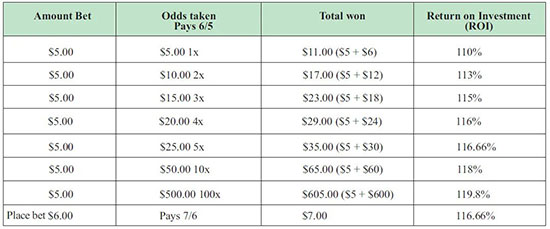MAXIMIZING RETURNS
Casino Math (House edge %) vs Real Math (ROI $$)
By Garrison Russell
 When players take a lesson at the craps table or read a book, the first thing they’re taught is always make a pass line bet and a come bet and take your odds because you’re getting a lower house edge. Unfortunately you’re not playing for a lower house edge, you’re playing for money $$$$.
When players take a lesson at the craps table or read a book, the first thing they’re taught is always make a pass line bet and a come bet and take your odds because you’re getting a lower house edge. Unfortunately you’re not playing for a lower house edge, you’re playing for money $$$$.
The key to the game of craps is to place your money on the parts of the table that give you a higher return on investment (ROI). One of the biggest controversies in the game of craps has always been the come bettor versus the place better. Come bets are not the best bets for the player for the following reasons. The player does not get to pick their number. Yes, they win on the 7,11 but that is only eight out of thirty-six combinations, or 22.2%, that they will win. They have four ways to lose when they roll a 2, 3 or 12 (11.1%). The other 24 combinations ( 66.6%) are point numbers 4-10 that they now have to roll twice to win. First, the come bettor has to get their bet into play and then it has to be rolled a second time for the player to win. They only get paid the second time the number is rolled and then their bet is returned back to them and they have to start all over. In Vegas we call these players Yo-Yo players, up and down, up and down. The place bettor gets paid every time the number is rolled and that bet has options. After the place bet wins they can say, “same bet, press my bet, regress my bet, or take it all down.” They have options with their money. The come bettor has no options with their bet. The key to any bet is how much you are betting and how much you’re winning or losing, known as your ROI.
The below chart is for the come/pass line bettor for 1X to 100X odds for the points six and eight. You can see when the bettor makes a pass line or come bet with single odds their return on investment is 110%. Example: Bet $5 and take $5 odds. They win $11 ( $5 + $6 odds) for a return on investment of 110%. If they take a pass line bet at 2X odds their return on investment is 113%. If they place the six or eight for $6 or $12 their return is 116.66% (7÷6 is 116.66%). It takes 5X odds for the pass line and come bettor to get the same return on investment as the place bettor at 116.66%. Most books tell you your house edge is a low 0.8% when taking single odds and you’re fighting a house edge of 1.5% when you place the number. That is only a 0.7% difference.

What the books and the casinos don’t tell you is a come bet and odds bet is a two-part bet. You can’t take an odds bet until you make an even-money pass-line or come bet and that lowers your return on investment. When you work out the math you have to work out the math for both bets, not just the odds. The place bettor is getting full place odds on every unit. If you are playing at a $25 minimum table you have to have a $25 come bet and additional $125 in odds (5X odds) to get the same return on investment as the place bettor who is just placing a number for $30 or $36. Why risk that much money to get a return of 116.66%? Just place the six and eight for $30 or $36 and stay in the game longer. You should have no more than 10% to 20% of your money in play at one time.
When playing the game of craps consider playing for a higher return on investment and don’t worry so much about the lower house edge. There’s a saying that the pros know that goes: “All this house edge is crap, with a capital C.”
When you place the five or nine your return on investment is 140% on each unit.
(7÷5 is 140%) when you take a pass line or come bet and with single odds your return is 127.27%. When you take double odds your return is 133.33%. Example: Take a come bet of $5 with single odds. Your bet is $11 ($5 + $6 odds); you win $14. Your return on investment is 127.27%.
It takes FOUR times odds to get the same return on investment as the place bettor who is winning 140%. Again, they say the place bettor is fighting a house edge of 4%. So what! To get a house edge of 0.8% you have to make two bets—your even money bet and then your odds bet. This is why the casinos limit how many odds you can take. Most casinos are 3X, 4X, 5X odds. The place bettor can bet all the way up to the table maximum and has options after they win their bets. The come bettor has no options whatsoever. If the come bettor wants to call off his bets he can only call his odds off. Come bets work on the first roll of the game, known as the come-out roll. When the player has a bet on the pass line and rolls the seven they win on the pass line but they lose all their come bets (keep your odds); now the player is in the hole. Place bets do not work on the come-out roll and they don’t lose any of their money.

When you place the four and 10 your return on investment is 180% (9÷5 is 180%)
If you take a come bet with single-time odds your return on investment is only 150%. Example: Bet $10 with $10 odds. You win $30 ($10 plus $20 odds=$30). It takes a player four times odds to get to 180% return on investment and most casinos only allow three times odds on the four and 10. When the player gets to a $25 bet they can buy the four and 10 and some casinos will let you buy the five and nine. Your return on investment is even higher than the place bettor.
When you sit down and work out the math you’ll see that the return on investment for the place/buy bettor is much higher than the come bettor, plus they have control over their bets. The come bettor has no control over his bets whatsoever. When playing craps you have to look at all your options and see what’s the best value for the player. When making place/buy bets the players have a lot more options such as the same bet, press it, regress my bet, take me down, etc. The come bettor does not have any options. They are at the mercy of whatever the dice roll. Remember, you only have eight ways to win with the seven and 11, four ways to lose with the two, three and 12, and the other 24 combinations are point numbers four through 10 that you now have to roll twice to win. The place bettor is winning on every roll of that number. Winning at craps is not how much you win in the come box with the seven or 11, it is how you handle your place and buy bets and knowing your options for those bets.
After playing craps for over 35 years I’ve never heard a dealer, box person, pit boss or the person in the cashier’s cage say: “Since you were playing for a lower house edge we are going to pay you more money.” That has never happened. What they always ask is: “How much money do you have in chips, because that’s what we are going to pay you.” When playing the game of craps consider playing for a higher return on investment and don’t worry so much about the lower house edge. There’s a saying that the pros know that goes: “All this house edge is crap, with a capital C.” For additional information, watch the show on YouTube: “The Top Ten Myths In Craps.”
I wish you the very best at the casinos and as always, Good luck at the tables!
Garrison is a teacher and the author of the Platinum Craps & Dice Setting book. His shows are on YouTube @ “So You Wanna Be a Gambler” website: www.platinumcraps.com, Amazon, and email: garrisoncraps@gmail.com. Office: 702-487-5223; Text 702-772-6011


